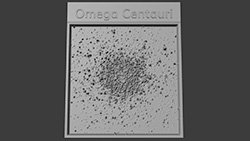CXC Home | Search | Help | Image Use Policy | Latest Images | Privacy | Accessibility | Glossary | Q&A
1
X-ray, Optical, & Infrared Images of Omega CentauriX-ray: NASA/CXC/San Francisco State Univ./A. Cool et al.; Optical: NASA/ESA/STScI; IR: NASA/JPL/Caltech; Image Processing: NASA/CXC/SAO/N. Wolk
Astronomers have studied “spider pulsars” — a special class of rapidly spinning objects that are stripping companion stars of their atmospheres — in Omega Centauri and other globular clusters. Astronomers combined X-rays from Chandra with radio data to better understand these exotic objects. Chandra's sharp X-ray vision is crucial for studying these kinds of objects in globular clusters because they often contain many X-ray sources in a small field of view. In these images, the Chandra data are shown along an optical view from Hubble and infrared view from Spitzer.
2
3D Printable Files: Omega Centauri(3D Print Credit: NASA/CXC/A. Jubett, using software by Tactile Universe/N. Bonne & C. Krawczyk & Blender)
This tactile plate of a globular cluster features a physical relief map based on the intensity of X-ray, Infrared & Optical data. A globular cluster is a sphere-shaped collection of stars bound together by gravity.
Scores of tiny stars dot the space, many jutting out of the plate. Like other globular clusters, this conglomeration, named Omega Centauri, is more densely packed near the center.
In Omega Centauri are eleven spider pulsars toward the inner half of the sphere, which obliterate their companion stars with strong winds of particles. Each spider pulsar is the spinning core of a collapsed massive star. As they spin, the spider pulsars emit beams of radiation, like light from a lighthouse. The pulsars also produce winds of particles that methodically strip away their companion stars, layer by layer.
Scores of tiny stars dot the space, many jutting out of the plate. Like other globular clusters, this conglomeration, named Omega Centauri, is more densely packed near the center.
In Omega Centauri are eleven spider pulsars toward the inner half of the sphere, which obliterate their companion stars with strong winds of particles. Each spider pulsar is the spinning core of a collapsed massive star. As they spin, the spider pulsars emit beams of radiation, like light from a lighthouse. The pulsars also produce winds of particles that methodically strip away their companion stars, layer by layer.
Return to: NASA's Chandra Catches Spider Pulsars Destroying Nearby Stars (November 30, 2023)









